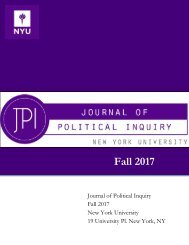Journal of Political Inquiry Fall 2014
Create successful ePaper yourself
Turn your PDF publications into a flip-book with our unique Google optimized e-Paper software.
emaining under the control <strong>of</strong> Ibrahim. 7<br />
ideology, and shifted into the terrorism-crime nexus. 8<br />
From here, D-Company adopted a degree <strong>of</strong> radical<br />
Cause: Shift in India’s Markets<br />
With rampant corruption and a closed economy, D-Company flourished as one <strong>of</strong> India’s<br />
top criminal organizations. But in the early 1990s, at the same time as the riots and destruction <strong>of</strong><br />
the Babri mosque, the economic and markets shifted in India, leaving many <strong>of</strong> D-Company’s<br />
activities less pr<strong>of</strong>itable. This was also a primary motivation for D-Company moving towards<br />
terrorist activities. Prior to 1991, the economy <strong>of</strong> India was dominated by the public sector, with<br />
limited international trade and socialist-oriented policies. Such economic policies had helped to<br />
cultivate criminal and black market activities within the country. However, in June <strong>of</strong> 1991 the newly<br />
elected Congress Party changed the fundamental structure <strong>of</strong> the Indian economy, devaluating the<br />
rupee immediately by twenty-five percent to alleviate the current account deficit. 9 By the end <strong>of</strong> the<br />
decade the Indian economy was averaging over 6 percent growth rate and witnessed a declining<br />
market for illicit activities. 10<br />
New business dealings with the Pakistani ISI created opportunities to diversify D-<br />
Company’s portfolio and created a new market for illicit activities. For example, a bond between al-<br />
Qaeda and D-Company was forged that allowed the use <strong>of</strong> smuggling routes by al-Qaeda members<br />
to escape over the Afghanistan border into Pakistan. This al-Qaeda connection gave D-Company<br />
the opportunity to deal in the Afghanistan heroin market. 11 Another major policy change was the<br />
liberalization <strong>of</strong> gold imports. Indian policy makers cut the duty rate in half from Rs 450/10gms to<br />
Rs 220/10gms. 12 The government <strong>of</strong> India seized nearly 5.7 and 5.0 tons <strong>of</strong> gold in 1990 and 1991,<br />
respectively, but by 1992 the amount seized had dropped to nearly 2.9 tons under the newly open<br />
policy. 13 This change in gold import policy marginalized D-Company’s gold smuggling enterprise<br />
7 Ryan Clarke "The PIRA, D-Company, and the Crime-Terror Nexus," Terrorism and <strong>Political</strong> Violence 20, no. 3 (2008):<br />
376–395.<br />
8 International Terrorism and Transnational Crime: Security Threats, U.S. Policy, and Considerations for Congress.<br />
9Manmohan Agarwal, Whalley, John. “The 1991 Reforms, Indian Economic Growth, and Social Progress.” National<br />
Bureau <strong>of</strong> Economic Research: Working Paper 19024, May 2013. Page<br />
10 U.S. Library <strong>of</strong> Congress, Congressional Research Service. India-U.S. Security Relations: Strategic Issues, by Alan<br />
Kronstady. CRS Report R42948. (Washington, DC: Office <strong>of</strong> Congressional Information and Publishing, 2013).<br />
http://fas.org/sgp/crs/row/R42948.pdf<br />
11 Ryan Clarke, Terror-Crime Nexus in South Asia, 85-87.<br />
12 Reserve Bank <strong>of</strong> India history series. Volume 4, 1981-1997, Part A<br />
13 Reserve Bank <strong>of</strong> India history series. Volume 4, 1981-1997, Part A

















